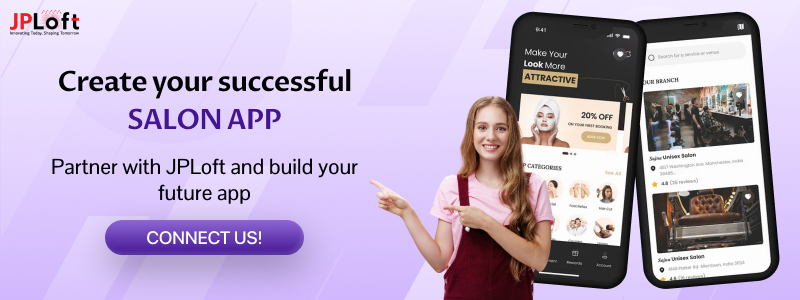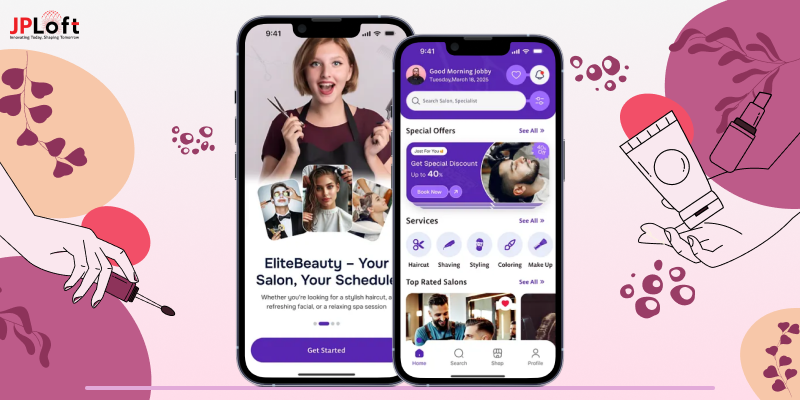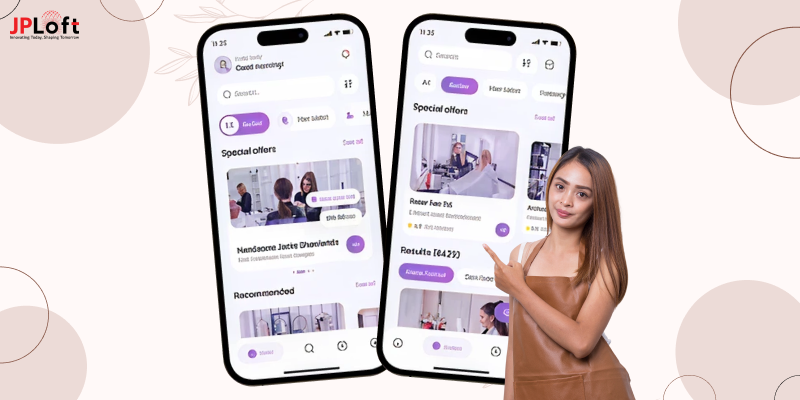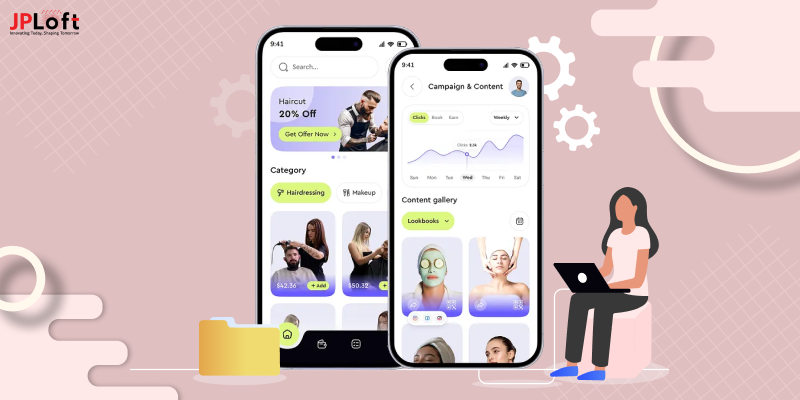Creating an app is not easy; it includes a lot of effort and resources, and when it fails, this destroys the hope too.
Then why not identify the patterns or reasons early that can lead to a salon app startup's failure?
"Most salon apps stumble not from a lack of features, but from failing to truly understand and serve their users' core needs."
Seth Godin, Bestselling Author and Marketing Guru
You are at the right place to learn it all. From salon apps, their stats, to reasons, examples, and strategies, we have covered it all.
Are you ready to learn about the reasons behind salon app startup failure?
Yes! Then let's proceed.
Salon App and Related Stats
Salon apps are mobile applications designed to streamline salon management and the booking process.
These salon apps offer features such as online appointment scheduling, customer management, marketing tools, and inventory management, which enable the salon apps to operate efficiently and enhance the customer experience.
The salon apps are engaging users through convenience booking options, personalized experiences, and loyalty programs. These apps include features like push notifications, online scheduling, and targeted marketing to help users book a service.
Now, let's have a look at salon market statistics below.
-
The spa and salon software market size is estimated at USD 1.01 billion in 2025 and is expected to reach USD 1.69 billion by the year 2030.
-
This market has grown from USD 813.16 million in 2024 to USD 865.52 million in 2025 and is projected to reach USD 1.22 billion by 2030.
-
The global beauty salon market was valued at USD 155.60 billion in 2022, and is expected to grow at a CAGR of 8% from 2023 to 2030.
-
In the U.S, Umax is the most downloaded app in the beauty app segment. This app was downloaded about 2.3 million times in 2024.
-
The beauty industry generates over $650 billion in revenue worldwide and is projected to generate up to $177 billion by 2025.
After analysing the current salon market trends and stats, you might be thinking of the failures in the industry.
Well, if you have to succeed, it's important to taste failure; however, some apps have faced such a devastating situation when it comes to failure.
Let’s learn how in the section below.
Reasons for Salon App Startup Failure
Why do most salon app startup fails?
When you create a salon app, it's essential to know the reasons why it might fail. This will help you to analyse the risk and then be prepared for the same.
Here is the list to discuss below.
1. Lack of Industry Knowledge
Insufficient knowledge about the industry is just one of the reasons for failing salon apps.
This might include ignoring the customer preferences, service quality expectations, and the importance of building relationships with both the stylists and clients.
Additionally, not analyzing the local competitors might result in pricing and service offerings that probably don’t resonate with the target audience.
For instance, if you aren’t aware of the role of AI in salon apps, you cannot proceed with implementing it, right?
2. Avoiding Market Research
If you are unaware of what is happening in the current salon market, then it might result in a loss for your dream app.
You can ignore the users’ actual demands and preferences if you avoid the market study. Along with this, avoiding customer feedback can also have a large impact on the development process.
Without understanding the customer needs, preferences, and market trends, you cannot resonate with the audience, which can result in a loss for your app.
3. Poor App Design
The poor mobile app UI/UX design can be a reason for your salon app startup's failure. This can result in low user engagement, high drop-off rates, and even lead to negative first impressions.
It can result in confusing navigation, complex functionality, and slow loading times, which might create frustration among the users, and they can switch the others. An ineffective salon app design can impact the overall trust and opinion of the users for your brand.
A poorly designed user interface (UI) can hamper the overall user experience and ultimately lead to users abandoning the app.
4. Neglecting the Technologies
If you neglect the technologies or are not aware of a suitable salon app tech stack, then it can lead to improper functioning of the app, and even lead to decreased bookings.
This further results in decreased accessibility of your app, where potential clients might find it inconvenient to schedule the appointments, and they can switch to other salons with better accessibility.
Avoiding potential technologies for your salon apps can hamper the overall performance, and this can impact your position in the competitive market.
5. Ineffective Budget Planning
Poor budget planning can result in rushed development, poor quality, missed deadlines, and ultimately, an unusable or unmarketable product.
Along with this, the lack of proper budgeting might result in scope creep, where items are added without considering the cost implications, which further exacerbate the problem.
When you find the budget low, you might end up with a buggy, unreliable app with a poor user experience, resulting in low user adoption and even negative reviews. Avoiding budget can increase the overall cost to build a salon app.
6. Scope Creep
If your project objective is not clear, this can result in scope creep.
When you expand the project’s requirements, this can significantly contribute to the failure of a salon startup by causing delays, budget overruns, and ultimately salon app failure.
It will lead to your project overruns, and ultimately to a poor user experience that drives away potential customers.
Well, each new feature or functionality addition beyond the initial plan might lead to increased costs. This can quickly deplete the resources and can potentially force you to abandon this project.
7. Competitive Pressure
High competition in the market can result in pressuring you to lower prices, and to offer unsustainable discounts, or neglect the crucial aspects of your business in an attempt to attract and retain customers.
This might lead to a lack of differentiation, poor user experience, and inability to effectively market the app, which can all be exacerbated through intense competition and ultimately cause an increase in the user churn rate.
Additionally, a lack of differentiation, poor online presence, and difficulty in adapting to market trends might contribute to the salon app’s downfall.
8. Poor Business Infrastructure
The poor business infrastructure can severely hinder an app’s success, failing in several ways. This might cause performance issues, hinder the user experience, and lead to an app’s abandonment.
Salon apps might experience slow loading times, even frequent app crashes, and can become unresponsive, all of which can negatively impact the user experience and even lead to frustration.
Thus, you should hire dedicated developers to help you in creating a defined business infrastructure.
9. Lack of Monitoring and Maintenance
Avoiding the monitoring and maintenance activity can result in app failure. Without the proper monitoring and maintenance, you might face issues with the infrastructure.
This might lead to performance degradation and even to potential failures.
Poor monitoring and a lack of mobile app maintenance will hamper the updates and can keep you behind the latest trends in the market, which can result in salon app failure.
10. Selection of Inadequate Features
If you are unaware of the potential series of salon app features to include in the app, it can impact the user experience and even hamper the brand's reputation, as well as its functionality.
Without selecting the adequate features, you will not be able to attain the desired project aim.
When the features are not accurate, it might result in errors and can bring operational issues for your salon app.
11. Failure to Adapt to Industry Trends
When you avoid the current industry trends and proceed with the salon app, then this can lead to outdated offerings and a decline in customer interest.
It can lead to the risk of losing clients to competitors who are more attuned to the current preferences. This can result in the loss of market share, reduced profits, and even business failure.
This might create stagnation and a decline as the business struggles to compete in the dynamic marketplace.
12. Insufficient staff Training
Do your staff know how to deal well with the demands of the users? Well, if not, then it can create an issue with your business's failure.
The lack of knowledge to deal with the app at the backend and to mitigate the technical aspects can be one of the important issues to be considered here.
An insufficient staff training can result in poor service quality, customer dissatisfaction, and ultimately lead to a decline in app usage.
These were some of the reasons to consider for a salon app startup's failure.
Now, let’s look forward to the case studies and salon apps that have failed in the real world.
Case Studies: Flop Salon Apps
You know well about the best salon apps that are leading the industry, now, let's talk about the ones that have failed.
Yes, there are salon apps that have failed.
Let’s learn from them the reasons so that you can lead the industry and avoid these pitfalls.
Example 1: Stylisted
The app has faced many hurdles that have ended up in failure.
The reasons are a high customer acquisition rate, which results in attracting and retaining customers in the competitive online styling market. Lack of differentiation and financial sustainability are other sets of challenges faced by this app.
Example 2: MyStyle App
The MyStyle app is likely to fail due to various factors, including a lack of vision, scope creep, and potentially issues with platform compatibility or marketing.
Along with this, the app has failed because of its redundant features and insufficient differentiation. Poor user experience is another error that has resulted in slow performance, difficult navigation, and technical glitches.
Example 3: Vanitee
The Vanitee app is a beauty and cosmetics app that has failed due to a flawed concept and potential negative reviews related to its services.
Additionally, the app seemed to have suffered from interface issues, limited personalization options, and a lack of a robust database. There are some customers who have reported a negative experience with the app.
Example 4: Priv (Initial App Version)
It is an app that’s suitable for booking wellness and beauty professionals. This app has failed due to several reasons, such as a lack of user interaction, and some users have even reported negative experiences with the app.
The app has even faced issues related to permissions, installation, or even with system integration.
These were some of the examples to be taken are of and lessons learned from. You can consider these lessons as the challenges while creating a salon app, to find a solution as per your customized app.
Well, till now, we have discussed the concept of the salon apps, their related stats, reasons for app failure, and real case examples.
Now, let's look forward to the practices that can lead to salon app success in the section mentioned below.
Practices to Avoid Salon App Failure
Learning about why salon app startups fail is not sufficient until you know the practices to achieve success.
Let’s learn it all here.
-
Clear Purpose and Objective: The purpose and objective of your salon app project should be clear and simple to understand. Here, you should avoid changing the features or objectives once that is planned at the beginning of app development.
-
Cluttered-Free Interface: Your salon app should be clutter-free, such as that users are required to know well where they can find the booking page, or even the list of services that the particular salon provides. Hence, the UI/UX of your salon app should be simple and effective.
-
Supportive Technologies: The backend of the app should be supportive of the features. These technologies should provide you with efficient space, can be high-tech, or even low-tech, to encompass a wide range of solutions for your users.
-
Secure APIs: An integration of the third-party apps should be supportive. When you integrate third-party apps into the salon apps, ensure that they are safe and secure to use. This comprises token-based authentication, HTTPS, and role-based access control.
-
Considering the Competition and Market: It's important to consider the competitive market and the current market dynamics. You should adopt the practice of analyzing the competitors, their strategies, and market trends, which may help to identify current opportunities and understand the users’ demands.
-
Hyper-Personalization: You should opt for the hyper-personalization, which comprises of right tools, through which the salon can automatically send notifications to the users related to their bookings and upcoming appointments.
Are you ready to lead the industry?
Well, connecting with the leading development company can help here.
Partner with JPLoft and Avoid App Failures
Are you searching for a professional team of developers?
Well, connecting with the leading Salon App Development Company can be helpful. We are here to help you provide the insights related to current market trends and technologies.
JPLoft is here to guide you on all the requirements related to creating your dream salon app. Our team can make market searches, advise you on the features, and even maintain your dream app.
We are here to listen to your ideas and then help to mold them as per the requirements of the target audiences and market demands.
Conclusion
To truly succeed with a salon app, understanding the pitfalls is as crucial as identifying opportunities.
From neglecting market research and industry nuances to poor design, ineffective budget planning, and the perils of scope creep, numerous factors can derail even promising ventures.
Learning from the failures of apps like Stylisted, MyStyle, Vanitee, and early Priv iterations highlights the critical need for a clear vision, robust technology, a user-centric approach, and continuous adaptation to market trends.
By prioritizing meticulous planning, supportive infrastructure, and embracing hyper-personalization, startups can navigate challenges and carve a path towards sustained success in this dynamic industry.
FAQs
Salon apps are mobile applications created to streamline salon management, enhance customer experience, and simplify the booking process for users.
Avoiding market research is a major reason, leading to a lack of understanding of user demands, preferences, and current market trends, which results in apps that don't resonate with the audience.
Poor app design (UI/UX) leads to low user engagement, high drop-off rates, negative first impressions, confusing navigation, and slow loading, ultimately causing user frustration and abandonment.
Scope creep is when project requirements expand beyond the initial plan. It causes delays, budget overruns, and can result in an unusable product dueating resources and leading to failure.
Yes, examples mentioned include Stylisted (high customer acquisition, lack of differentiation), MyStyle App (lack of vision, poor UX), Vanitee (flawed concept, interface issues), and Priv (initial version, user interaction problems).












Share this blog